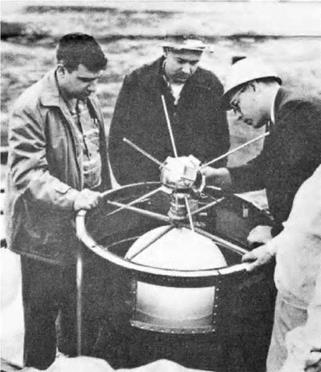The Vanguard I launch
The Vanguard program had its first success with the launch of their spherical test satellite. Vanguard I, launched on 17 March 1958, being 6.44 inches in diameter as seen in Figure 10.5, became referred to in some of the press reports as the “grapefruit” satellite.
That satellite, however, even without any internal active scientific instruments, achieved a list of notable firsts. To start with, its high orbit (initial perigee of 406 miles and apogee of 2,421 miles) resulted in a very long orbital lifetime. The current estimate is that it will not reenter the Earth’s atmosphere for at least 2000 years. It represents the first use of solar cells for power generation in space. Another major technical achievement was the validation of the thermal design that had been worked out for the larger Vanguard satellites that followed.
Precision tracking of Vanguard I over an extended period by NRL and the Smithsonian Astrophysical Observatory resulted in the discovery that the Earth is not a spherical globe somewhat flattened at the poles, as previously thought, but is
 OPENING SPACE RESEARCH
OPENING SPACE RESEARCH
![]()
|
pear shaped. It also revealed variations in atmospheric density related to the rotation of the Sun and that the density of the upper atmosphere is far greater than formerly supposed.











